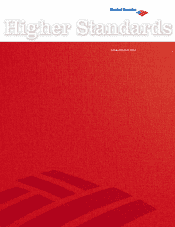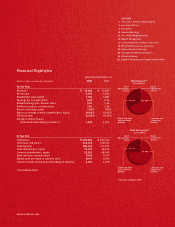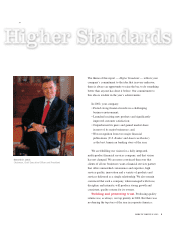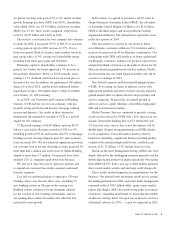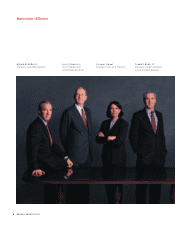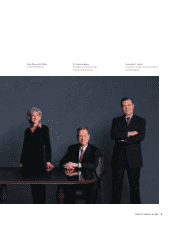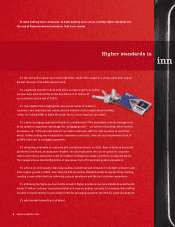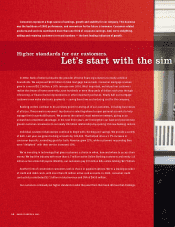Bank of America 2002 Annual Report Download - page 5
Download and view the complete annual report
Please find page 5 of the 2002 Bank of America annual report below. You can navigate through the pages in the report by either clicking on the pages listed below, or by using the keyword search tool below to find specific information within the annual report.
we pursue our long-term goal of 7% to 9% annual revenue
growth. Earnings per share (EPS) were $5.91, shareholder
value added (SVA) was $3.76 billion, and return on equity
(ROE) was 19.4%; these results compared, respectively,
to $4.18, $3.09 billion and 14.0% in 2001.
The result is a stock price for your company that continues
to climb. In 2002, it increased 10.5% to $69.57 at year-end,
a strong gain on top of a 2001 increase of 37%. Over a
three-year period, Bank of America ranks number one in its
peer group with a 15.9% average total shareholder return,
including both stock price gains and dividends.
Returning capital to shareholders continues to be a
priority. In October, the board approved a 7% increase in
the quarterly dividend to $0.64, or $2.56 annually, repre-
senting a 3.7% dividend yield based on our stock price at
the end of the year. In addition, we repurchased 109 million
shares of stock in 2002, and the board authorized further
repurchases of up to 130 million shares within 24 months
at its January 22, 2003 meeting.
As in 2001, our Consumer and Commercial Banking
business (CCB) led the way for our company, with par-
ticularly strong growth in card income, mortgage banking
income and deposits. Our results in these businesses
demonstrate the tremendous strength of CCB as a growth
engine for our company.
CCB posted earnings of $6.09 billion, up from $4.95
billion a year earlier. Revenue growth in CCB was 9%,
including growth of 8% in card income and 27% in mortgage
banking income. Average deposits grew 6% and consumer
loans increased 16%. We also achieved significant growth in
our customer base as net new checking accounts increased by
more than half a million and active users of Online Banking
surged to more than 4.7 million. Commercial loan levels
declined 12% as companies paid down loan balances.
We also took steps this year to open new markets and
to expand our customer base in the consumer and small
business segments.
Last fall, we announced plans to open up to 550 new
banking centers over the next three years, including 15
new banking centers in Chicago in the coming year.
Banking centers continue to be the dominant channel
for the creation of new banking relationships, and we
are opening these centers in markets that offer the best
potential for new growth.
In December, we agreed to purchase a 24.9% stake in
Grupo Financiero Santander Serfin (GFSS), the subsidiary
of Santander Central Hispano in Mexico, for $1.6 billion.
GFSS is the third-largest and most profitable banking
organization in Mexico. The transaction is expected to close
in the first quarter of 2003.
This investment was driven by our desire to better
serve Hispanic customers within our U.S. franchise and to
increase our presence in all our Hispanic communities. Our
relationship with GFSS will enable us to better understand
our Hispanic customers, enhance our products and services
and position Bank of America as the bank of choice for the
Mexican-American population in our key markets. Finally,
the investment met our stated financial hurdles and will be
accretive to earnings in 2003.
Our Global Corporate and Investment Banking business
(GCIB), by focusing on clients in industry sectors with
high growth potential and where we have specific expertise,
gained market share in almost all of its major product and
service categories. In particular, we gained ground in
advisory services, equity offerings, convertibles, high-grade
debt and asset-backed securities.
Global Treasury Services continued to provide a strong,
steady income stream for GCIB with a 26% increase in net
income. Investment banking fees of $1.5 billion fell only
3% from last year, even as fees across the industry fell by
double digits. Despite strong performance in GCIB relative
to our competitors, lower demand in market-sensitive
businesses (including a significant decline in trading profits),
coupled with continued high credit losses, resulted in net
income of $1.72 billion, a 12% decline from last year.
Results in the Asset Management Group (AMG) also were
deeply affected by the challenging economy generally and the
double-digit decline in the stock market specifically. Net income
from AMG fell 23% from a year ago to $404 million, primarily
due to weak market activity and one large credit charge-off.
These results masked important accomplishments for the
business. Our mutual funds investment results put us among
the leading performers in 2002, and assets under management
remained stable at $310 billion while, again, major market
indices fell sharply. AMG also made strong gains on its great-
est priority: expanding distribution by increasing the number
of advisors serving clients. Our goal was to increase our force
of financial advisors by 20% — a goal we surpassed in 2002.
3
BANK OF AMERICA 2002

